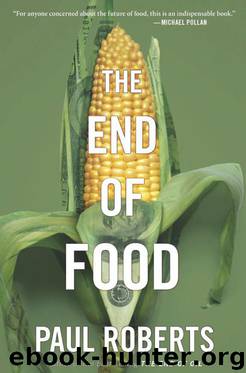The End of Food by Roberts Paul

Author:Roberts, Paul [Roberts, Paul]
Language: eng
Format: epub
Publisher: Houghton Mifflin Harcourt (www.hmhco.com)
Published: 0101-01-01T00:00:00+00:00
On a poultry farm in the busy, smog-choked outskirts of Hefei, a city halfway around the world from the Salinas Valley, the collision between food production and food pathogens enters the epidemiological equivalent of the major leagues. Our host, a compact, neatly dressed man who gives only his surname, Wu, raises a breed of chicken known for its blackish meat that is said to possess medical powers and that Wu sells for a high price to "rich city women worried about circulation problems." It's a tiny operation by Western standards—twenty-six thousand birds housed in seven crude, Quonsetlike barns—but such a small scale means Wu can cut costs by handling many of the daily chores himself, from feeding and cleaning to the routine injection of antibiotics for "disease control." The small scale may also explain Wu's low-budget approach to avian flu: whereas poultry farmers in North America or Europe would make me put on a protective suit and footwear (or, more likely, wouldn't let me visit at all), Wu simply directs me to walk through a pan of chalky white antibacterial powder at the farm's gated entrance. The fact that such a barrier is unlikely to stop a pathogen like H5N1, which can travel through the air, doesn't appear to be too great a concern to Wu. He is far more focused today on the fact that demand for chicken is rising so fast that he is building an eighth barn to keep up. "Yes," says Wu of the meat business. "It should be a great future."
It is, of course, precisely the ambition of men like Wu in places like Hefei that causes so much anxiety among experts in avian influenza. For all the ready benefits of rapidly expanding meat production in Asia, Africa, and elsewhere in the developing world, the pace and character of this belated livestock revolution are generating a rising tide of pathogens whose potential for havoc makes E. coli and salmonella seem almost insignificant. And of these emergent and reemergent diseases, none has the potential of high-pathogenic avian influenza, or HPAI. Beyond the sheer nastiness of the disease itself (60 percent of those infected with the current HPAI variant, H5N1, die excruciating deaths), its expansion into the human food supply appears inexorable, driven not only by the pathogen's great adaptability but also by the fact that its points of attack are on two food items—rice and poultry—that the world, and especially developing countries like China, couldn't live without.
Avian flu has been lurking in the margins of the food industry for decades. Although the virus's native reservoir is wild waterfowl, like other pathogens have, it has entered the human food chain at points where farm activities have pushed into wild habitat. In this case, the intersection occurred in the massive wetlands that Asian farmers use as rice paddies. After each harvest, farmers bring their domestic ducks into the paddies to eat the spilled grain in the water. Unfortunately, these wetlands are also feeding grounds for migratory waterfowl, some of which carry the virus.
Download
This site does not store any files on its server. We only index and link to content provided by other sites. Please contact the content providers to delete copyright contents if any and email us, we'll remove relevant links or contents immediately.
Craft Beer for the Homebrewer by Michael Agnew(17447)
Marijuana Grower's Handbook by Ed Rosenthal(3119)
Barkskins by Annie Proulx(2880)
Project Animal Farm: An Accidental Journey into the Secret World of Farming and the Truth About Our Food by Sonia Faruqi(2661)
Red Famine: Stalin's War on Ukraine by Anne Applebaum(2464)
The Plant Messiah by Carlos Magdalena(2454)
Organic Mushroom Farming and Mycoremediation by Tradd Cotter(2307)
0041152001443424520 .pdf by Unknown(2220)
In the Woods by Tana French(1997)
Beer is proof God loves us by Charles W. Bamforth(1921)
The Art of Making Gelato by Morgan Morano(1900)
Meathooked by Marta Zaraska(1886)
Birds, Beasts and Relatives by Gerald Durrell(1863)
Reservoir 13 by Jon McGregor(1852)
The 7 Habits of Highly Effective People: Powerful Lessons in Personal Change (25th Anniversary Edition) by Covey Stephen R(1836)
Borders by unknow(1786)
The Lean Farm Guide to Growing Vegetables: More In-Depth Lean Techniques for Efficient Organic Production by Ben Hartman(1785)
The 7 Habits of Highly Effective People: Powerful Lessons in Personal Change by Stephen R. Covey(1765)
Urban Farming by Thomas Fox(1749)
